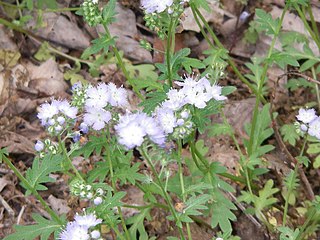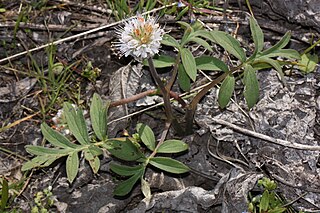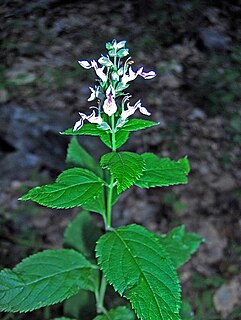
Carduus nutans, with the common names musk thistle, nodding thistle, and nodding plumeless thistle, is a biennial plant in the daisy and sunflower family Asteraceae. It is native to regions of Eurasia.

Hydrophyllum is a genus of herbaceous perennial plants in the waterleaf family. It consists of nine species, all of which are native to North America.

Cardamine hirsuta, commonly called hairy bittercress, is an annual or biennial species of plant in the family Brassicaceae, and is edible as a salad green. It is common in moist areas around the world.

Phacelia purshii, known by the common names Miami mist, scorpionweed, and purple scorpionweed, is a spring flowering annual forb with blue, lavender, violet, or nearly white flowers in the Boraginaceae (borage) family that is native to eastern and central North America.

Sabatia angularis, commonly called rosepink, rose pink, or rose gentain is a biennial flowering plant in the Gentianaceae (gentain) family. It is native to central and eastern North America.

Asarum canadense, commonly known as Canada wild ginger, Canadian snakeroot, and broad-leaved asarabacca, is a herbaceous, perennial plant which forms dense colonies in the understory of deciduous forest throughout its native range in eastern North America, from the Great Plains east to the Atlantic Coast, and from southeastern Canada south to around the Fall Line in the southeastern United States.

Echinacea simulata, commonly called wavy leaf purple coneflower, glade coneflower, or prairie purple coneflower, is a species of perennial flowering plant in the family Asteraceae. It is native to the east-central states of the United States. Its natural habitat is dry, calcareous, open areas such as barrens and woodlands.

Polemonium eximium, the skypilot or showy sky pilot, is a perennial plant in the phlox family (Polemoniaceae) that grows at high altitudes. It is endemic to the Sierra Nevada in California where it grows in the talus of the high mountain slopes.

Erigeron annuus, the annual fleabane, daisy fleabane, or eastern daisy fleabane, is a species of herbaceous, annual or biennial flowering plant in the family Asteraceae.

Hydrophyllum occidentale is a species of flowering plant in the waterleaf family known by the common name western waterleaf.

Iliamna bakeri is an uncommon species of flowering plant in the mallow family known by the common names Baker's globe mallow and Baker's wild hollyhock.

Machaeranthera tanacetifolia is a species of flowering plant in the family Asteraceae known by the common names tansyleaf tansyaster and Tahoka daisy. It is native to northern Mexico and the southwestern and central United States, where it grows in several types of habitat. It is an annual or biennial herb growing one or more branching stems up to about 70 centimetres in maximum height. The multilobed leaves are up to 12 cm long. The inflorescence bears one or more flower heads lined with spreading or curling, pointed phyllaries. The head has a center of many yellow disc florets and a fringe of many lavender to purple ray florets each 1 to 2 cm long. The fruit is a flat achene about 1 cm long including the pappus.

Hydrophyllum capitatum, is a species of waterleaf known by the common name ballhead waterleaf. It is native to Western North America from British Columbia to Utah.

Asclepias quadrifolia, commonly called four-leaved milkweed or fourleaf milkweed, is a species of milkweed in the Apocynaceae (dogbane) family. It is sometimes referred to as whorled milkweed, but it should not be confused with Asclepias verticillata. A. quadrifolia occurs in the eastern United States and Canada.

Verbesina virginica, known by the common names white crownbeard, or frostweed is a species of flowering plant in the family Asteraceae. It is native to the Southeastern United States, where it is found in calcareous soil, often in bottomland thickets and edges of woods.
Hydrophyllum brownei, or Browne's waterleaf, is a rare North American plant species found only in the Ouachita Mountains in Arkansas. It grows in forested hillsides above the Cossatot River in Howard County, as well as in Polk and Garland Counties.

Elephantopus carolinianus, with the common names Carolina elephantsfoot or leafy elephant's foot, is a species of flowering plant in the Asteraceae family. It is native to the south-central and southeastern United States.

Hypericum boreale, also known as northern St. John's-wort, is a short-lived perennial species of flowering plant in the family Hypericaceae, section Trigynobrathys.

Teucrium canadense, commonly known as Canada germander, American germander or wood sage, is a perennial herb in the family Lamiaceae. It is native to North America where it is found across the contiguous states of the United States and in much of Canada.

Hydrophyllum canadense, known as bluntleaf waterleaf, broadleaf waterleaf, or Canada waterleaf, is a flowering plant in the borage family, Boraginaceae. It is native to the eastern United States and Canada.



















